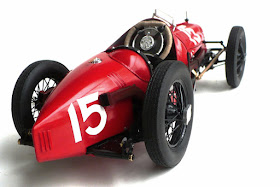Here are some images of Italeri's (Protar Molds) 1/12 scale Fiat 806 Grand Prix.
From Wikipedia"
The Fiat 806 Driven Stroke, sometimes described as the Fiat 806 and Fiat 806/406 Grand Prix, was a racing car created by the Turin-based company in 1927 , which represented the first cars to Grand Prix ever built. For the Fiat it was also the last.
In 1923 the persuasoria ability to Enzo Ferrari , at the time of the driver and factotum ' Alfa Corse , had torn Vittorio Jano and his coaching entourage at Fiat, to bring it to' Alfa Romeo . After the resounding defeat at the Lyon Grand Prix of 1924 , feeling betrayed, Giovanni Agnelli
took one of his decisions in a rush: the racing team Fiat withdrew from
the Grand Prix and suspended the construction of the new car from Grand Prix, designed by the young engineers Quiet Zerbi and Alberto Massimino .
But the choice had favored the Alfa Romeo that, in the absence of her
rival, began collecting a number of important sporting victories that
stimulated sales at the expense of Fiat. Determined to break the supremacy of the ' Alfa Romeo P2 , in 1927 the Fiat leadership gave orders to the Department special construction to start developing a car that can fulfill that undertaking, demonstrating the competitiveness of the Turin maintained.
Moreover, the new international regulation of the Formula Grand Prix had diminished the capacity maximum of 2,000 to 1,500 cm³ and the latest version of the previous model " 805 " was now at its maximum possible evolution. It was therefore necessary to build a completely new car. Zerbi and Massimino dusted off the previous project, making substantial changes.
Both the engine and the chassis were designed to exceed in originality and performance, the limits set by the technical era.
For the engine were devised two half-blocks of six cylinders in line to be coupled to form a twelve-cylinder engine with available U . The distribution was two overhead valves, controlled by three overlying camshafts and boost was provided by a compressor Roots .
The most innovative part, however, was in the frame and bodywork.
In order to lower the center of gravity the two engineers thought to
prepare the engine and gearbox no longer rests on the two supporting
spars of the frame, but sandwiched between them, including giving
greater torsional rigidity.
The solution involved a smaller distance between the longitudinal
members which did not allow sufficient space for the traditional
passenger compartment.
However, the improved reliability of the engines had already dispensed
with the presence of the co-driver-mechanic, at least for the
short-lived races, and it was decided to remove the seat next to the
pilot, thus creating the first grand prix in history motoring.
In all four engines they were built twelve-cylinder "Type 406" and a single frame "Type 806".
Compared
to the technical specifications of the time, the Fiat 806 came
immediately notice the ground clearance and the very small front
section. The house declared a power of 187 hp at 8,500 rpm / min and a speed of about 240 km / h , with an average consumption of about 35 liters per 100 km.
Equipped with a 4-speed gearbox and reverse, he boasted rigid axle
suspension and mechanical shocks, with drum brakes on all four wheels,
mechanically controlled and assisted by hydraulic brake booster.
Embellished with many technical innovations and an engine of exuberant
specific power, the "806" immediately revealed to the two test drivers, Salamano Carlo and Pietro Bordino , the difficulty of development and the fragility of the engine to the prolonged efforts. Not to mention the inadequacy of the components of that time, compared to the benefits.
For these reasons it was decided to register the car to the Grand Prix of Milan , on the distance of 50 km, and not at the European Grand Prix , on the distance of 500 km. Both races disputed, consecutively, on September 4, 1927 on the circuit of Monza .
The renewal of the challenge at the summit between Fiat and Alfa Romeo
brought an overflow crowd on the circuit, despite the heavy rain the day
and insistent. In addition to the return from the USA , he returned to Pietro Bordino for the occasion from the USA
, where he had moved after the withdrawal of Fiat from racing, to
attract the crowd contributed to the presence of the steering wheel axis
of Milan Grand Prix as Giuseppe Campari , Aymo Maggi , Emilio Mattresses and Tazio Nuvolari .
The track conditions due to rain were particularly unfavorable to the
Fiat 806 and its super-fractionated engine that certainly could not
excel in elasticity and smoothness of delivery.
However, due to the superior stability of the new chassis, Bordino won
the preliminaries batteries, making sure to end what today would be
called the pole position and won the victory, in front of ' Alfa Romeo P2 from Campari and Bugatti T35
Maggi, inflicting gap of more than a minute for the second place and
also clinching the fastest lap of the entire motoring day, at an average
of 155.410 km / h.
After this test of competitiveness, everything augured well for the season of 1928
, but the Fiat considered ended the demo experience, and announced his
retirement again in the Formula Grand Prix, this time, was final.
The order of destruction of the prototype and the accompanying materials came directly from the Agnelli senator . The Fiat 806 and the spare engines were dismembered to recover reusable parts and the rest came under the press , for the smelter . To document the progenitor of the modern single-seater Formula 1 , there are only a few photographs.









Oh you know i do like this one, what a classic and what a great looking kit....very nice.
ReplyDeleteThanks!
ReplyDeleteVery pretty,
ReplyDeleteI love old cars
Son sin duda muy elegante.
ReplyDelete